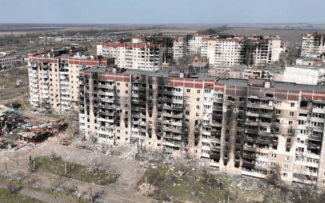Vuhledar in Russia’s hands. Day 950 of the war

![]()
On 1 October, Russian infantry occupied most of Vuhledar, including the headquarters of the local authorities. During the last days of September, Russians systematically pushed the Ukrainians out of their positions to the east and west of the city, allowing them to bring the exit roads within firing range and facilitating the assault on built-up areas. It is not known how high the losses on both sides are and whether Russians managed to cut off part of the enemy grouping. The fighting for Vuhledar has been ongoing with varying intensity since March 2022, i.e. since the Russian offensive was halted on the line of the nearby Kashlahach River. Russians had twice made massive attempts to capture the town (in November 2022 and January–February 2023). These ended with very heavy losses in men and armour. They only managed to change the situation in 2024, when they pushed the Ukrainians out of the positions they occupied east of the town over a few months.
Vuhledar, located on a hill dominating an unforested area, was a very advantageous point of resistance. At the same time, the residential blocks offered good shelter from Russian artillery shells and aerial bombs. The continued cohesiveness of the Ukrainian defence in this part of the Donbas depends heavily on the state of the fortifications. Another Russian target in the area is Kurakhove (about 20 km north of Vuhledar). It is assumed that the invaders will want to flank them from the north and south-west.
On the other sections of the front, there has been no significant change in the position of the parties. Heavy fighting continues mainly in the Donbas, as well as – locally – on the border of Luhansk and Kharkiv oblasts and in the Kursk Oblast. Russian advances in the main striking direction in the Donetsk Oblast, i.e. in the Pokrovsk, Myrnohrad and Selydove areas, have been reduced to a minimum. On 26 September, Russians attempted to break through the enemy's defences in the vicinity of the villages of Kruhlakivka and Kolisnykivka (about 20km south of Kupiansk in the Kharkiv Oblast) in order to break their grouping in two and reach the Oskil River. The attack by mechanised groups numbering around 50 tanks, infantry fighting vehicles and armoured personnel carriers in Sumy was repulsed, mainly using strike drones.
![]()
Over the past week, Russia has attacked Ukraine daily with Shahed 131/136 drones. Between the night of 24–25 September and the morning of 1 October, at least 345 drones of this type flew into its airspace, 298 of which are believed to have been shot down by air defence. Some of the others were jammed by radio-electronic warfare means and went off course, crashing in unknown locations or flying into Russian and Romanian airspace. According to the Ukrainian Air Force Command, the effectiveness of strikes using Shahed 131/136 drones last week was lower than 10%. On 28 September, the Russians attacked a hospital in Sumy using these drones, damaging some buildings and killing at least ten people. This is another attack on a civilian health facility that meets the criteria of a war crime. A day earlier, an attack by drones on the port of Izmail on the Danube killed three civilians. In addition, Russian drones managed to destroy or severely damage energy infrastructure facilities in the Ivano-Frankivsk and Mykolaiv oblasts, among others.
September 2024 became the first month during which the invaders used 'shaheds' on a daily basis. According to official communiqués, 1,339 of them entered Ukrainian airspace, of which 1,107 (83%) were shot down and some of the remainder were jammed by radio-electronic warfare means.
In addition to massive attacks by drones, the Russians used cruise and ballistic missiles in places, averaging several per day. Some of these hit their targets, including the destruction of one of the police office buildings in Kryvyi Rih on 27 September, which killed four people. On 26 and 27 September, Kinzhal missiles were fired towards central Ukraine, with no information on their number or impacts; judging by the laconic nature of Kyiv's official reports, the targets were probably military facilities.
![]()
On 25 September, Ukraine's State Service for Special Communications and Information Protection published a report entitled 'Russian Cyber Operations'. It reported that in 2022, Russia focused on operations to destroy critical information infrastructure and to acquire databases. In 2023, the strategy included obtaining information on the effectiveness of air attacks. Ukrainian analysts indicate that in 2024 there was an increase in the intensity of attacks on the IT network directly related to the conduct of military operations and on service providers providing digital resilience to the armed forces.
![]()
On 25 September, the US announced a further $375 million package of military support to Ukraine under the Presidential Drawdown Authority (PDA). It will provide air-to-ground munitions, including JDAM precision bombs and JSOW glide bombs, ammunition for HIMARS , 155 mm and 105 mm artillery munitions, TOW and Javelin anti-tank guided missiles, AT-4 grenade launchers, 150 M1117 armoured cars, nine armored vehicle-launched bridge and ten river patrol boats.
The following day, during President Volodymyr Zelensky's visit to the White House, the US pledged to mobilise a military support package worth a total of around $8 billion, of which $5.55 billion is PDA funding. Joe Biden delegated the authority to use these funds to Secretary of State Antony Blinken. The president further announced that the US will train an additional 18 Ukrainian pilots on F-16 aircraft and provide Kyiv with one more Patriot system battery.
A further $2.4 billion comes from the Ukraine Security Assistance Initiative (USAI) and is earmarked for the purchase of weapons and military equipment from the US arms industry. The Department of Defence will spend it on, among other things, munitions for Ukrainian air defence systems (mainly PAC-3 and AMRAAM missiles), air-to-ground munitions, unmanned aerial systems and components to support their production in Ukraine, and equipment to combat drones (on Zelensky's visit to the US, see ‘Zelensky visits the US: a diplomatic failure rather than a ‘victory plan’’).
On 25 September, the French press reported that Paris plans to hand over the first Mirage 2000-5F fighters to Kyiv by the end of the year. Moreover, the aircraft themselves are to undergo an upgrade before then. This is to involve adapting them to carry one SCALP-EG/Storm Shadow cruise missile or one anti-ship missile – the Mirage 2000-5Fs used by the French air and space forces are currently only capable of engaging air targets.
On 29 September, Denmark and Ukraine signed a series of agreements on further cooperation in defence procurement for the Ukrainian armed forces from the Ukrainian defence industry (no details were disclosed). The total value of the agreements amounts to DKK 4.2 billion (approximately €560 million), of which DKK 1.2 billion (approximately €170 million) comes from the Danish budget and DKK 2.9 billion (approximately €390 million) from interest on frozen Russian assets managed by Copenhagen on behalf of the EU. On the same day, an arms industry centre was established at the Danish embassy in Kyiv to strengthen strategic cooperation between the two countries in the defence industry and to support Danish companies in Ukraine.
![]()
On 26 September, a member of the Verkhovna Rada's Committee on National Security, Defence and Intelligence, Fedir Venislavskyi, confirmed that the only men over 50 who would be mobilised are those in possession of military specialisations which there is a shortage of. He stated that military units refuse to accept older conscripts unable to cope with frontline service.
On 1 October, Ukrainian Defence Minister Rustem Umerov announced the resignation of four of his eight deputies, responsible for logistics and financial issues, among other things. The reason for the reshuffle is said to be the need to "complete the process of cleaning up the army's procurement system in close cooperation with the law enforcement and anti-corruption authorities".
The most important organisational change is that the defence ministry has taken control of SpetsTechnoExport, an arms export and import company. It had previously been under the supervision of military intelligence. The change points to the weakening position of the latter's head, Kyrylo Budanov. Media speculation about the possibility of his dismissal is intensifying, especially after the defence minister dismissed his two deputies without providing a reason at the end of September. Umerov's decisions were most likely initiated by the Office of the President and are a reaction to disputes within the ministry's leadership over the management of financial issues, including the purchase of arms and military equipment. One day earlier, Zelensky had 'discussed' with Umerov plans to implement changes in the way institutions related to the state defence system operate.
![]()
On 30 September, Vladimir Putin signed a decree on autumn conscription. The process is to run from 1 October to 31 December, and 133,000 men aged 18 to 30 with Russian citizenship are to be drafted into service. The length of service has not changed and will be 12 months. The defence ministry there has assured that the conscripts will not take part in combat operations in Ukraine.
![]()
On 30 September, the Ukrainian Ministry of Justice provided assurances that citizens who were forcibly issued Russian passports in the occupied territories would not be held accountable. It stressed that forced passportisation is illegal and not recognised in Ukraine or internationally, as it contradicts the principles and norms of international law, including the Geneva Convention in its section on the protection of civilians in wartime.






